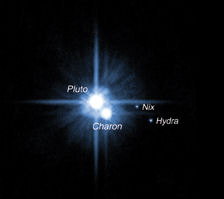Some deadly monikers
Pluto and its large moon Charon have some company in the underworld. Two recently discovered small moons orbiting Pluto have now been officially dubbed Nix and Hydra. Nix is the mythological goddess of the night. One of Nix’s offspring was Charon, who ferried the dead across the river Styx to hell. Hydra was a nine-headed, poisonous serpent that resided at the gate.

Discovered by astronomers using the Hubble Space Telescope in 2005, Nix and Hydra are about 0.02 percent as faint as Pluto and lie two to three times farther from Pluto than Charon does (SN: 11/5/05, p. 291: New Partners: Hubble finds more moons around Pluto). A ground-based telescope revealed Charon in 1978.
The International Astronomical Union, the authority charged with naming celestial bodies, announced the Nix and Hydra designations on June 21.
Nix and Hydra may share more than their underworld names with Charon. The three moons may have a common origin, suggest William R. Ward and Robin Canup of the Southwest Research Institute in Boulder, Colo. The three moons have similar orbital features, which indicate that they all coalesced from the debris created when a large object banged into Pluto early in the history of the solar system, Ward and Canup argue in the Aug. 25 Science. Their calculations suggest that Charon initially had an elongated orbit, which over time pushed Nix and Hydra into the more distant paths around Pluto that they now occupy.







